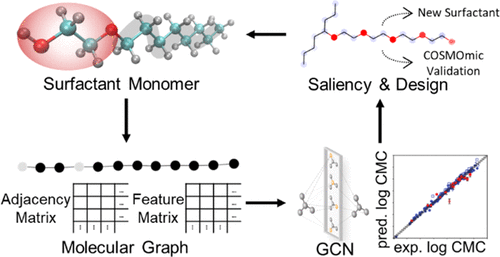当前位置:
X-MOL 学术
›
J. Phys. Chem. B
›
论文详情
Our official English website, www.x-mol.net, welcomes your feedback! (Note: you will need to create a separate account there.)
Predicting Critical Micelle Concentrations for Surfactants Using Graph Convolutional Neural Networks
The Journal of Physical Chemistry B ( IF 3.3 ) Pub Date : 2021-09-09 , DOI: 10.1021/acs.jpcb.1c05264 Shiyi Qin 1 , Tianyi Jin 1 , Reid C Van Lehn 1 , Victor M Zavala 1
The Journal of Physical Chemistry B ( IF 3.3 ) Pub Date : 2021-09-09 , DOI: 10.1021/acs.jpcb.1c05264 Shiyi Qin 1 , Tianyi Jin 1 , Reid C Van Lehn 1 , Victor M Zavala 1
Affiliation

|
Surfactants are amphiphilic molecules that are widely used in consumer products, industrial processes, and biological applications. A critical property of a surfactant is the critical micelle concentration (CMC), which is the concentration at which surfactant molecules undergo cooperative self-assembly in solution. Notably, the primary method to obtain CMCs experimentally—tensiometry—is laborious and expensive. In this study, we show that graph convolutional neural networks (GCNs) can predict CMCs directly from the surfactant molecular structure. In particular, we developed a GCN architecture that encodes the surfactant structure in the form of a molecular graph and trained it using experimental CMC data. We found that the GCN can predict CMCs with higher accuracy on a more inclusive data set than previously proposed methods and that it can generalize to anionic, cationic, zwitterionic, and nonionic surfactants using a single model. Molecular saliency maps revealed how atom types and surfactant molecular substructures contribute to CMCs and found this behavior to be in agreement with physical rules that correlate constitutional and topological information to CMCs. Following such rules, we proposed a small set of new surfactants for which experimental CMCs are not available; for these molecules, CMCs predicted with our GCN exhibited similar trends to those obtained from molecular simulations. These results provide evidence that GCNs can enable high-throughput screening of surfactants with desired self-assembly characteristics.
中文翻译:

使用图卷积神经网络预测表面活性剂的临界胶束浓度
表面活性剂是两亲性分子,广泛用于消费品、工业过程和生物应用。表面活性剂的一个关键特性是临界胶束浓度 (CMC),它是表面活性剂分子在溶液中进行协同自组装的浓度。值得注意的是,通过实验获得 CMC 的主要方法——张力测定法——既费力又昂贵。在这项研究中,我们表明图卷积神经网络 (GCN) 可以直接从表面活性剂分子结构预测 CMC。特别是,我们开发了一种 GCN 架构,以分子图的形式对表面活性剂结构进行编码,并使用实验性 CMC 数据对其进行训练。我们发现 GCN 可以在比以前提出的方法更广泛的数据集上以更高的准确度预测 CMC,并且它可以使用单个模型推广到阴离子、阳离子、两性离子和非离子表面活性剂。分子显着图揭示了原子类型和表面活性剂分子亚结构如何对 CMC 做出贡献,并发现这种行为与将构成和拓扑信息与 CMC 相关联的物理规则一致。遵循这些规则,我们提出了一小组新的表面活性剂,其中实验性 CMC 不可用;对于这些分子,用我们的 GCN 预测的 CMC 表现出与从分子模拟中获得的趋势相似的趋势。这些结果证明 GCN 可以高通量筛选具有所需自组装特性的表面活性剂。使用单一模型的阳离子、两性离子和非离子表面活性剂。分子显着图揭示了原子类型和表面活性剂分子亚结构如何对 CMC 做出贡献,并发现这种行为与将构成和拓扑信息与 CMC 相关联的物理规则一致。遵循这些规则,我们提出了一小组新的表面活性剂,其中实验性 CMC 不可用;对于这些分子,用我们的 GCN 预测的 CMC 表现出与从分子模拟中获得的趋势相似的趋势。这些结果证明 GCN 可以高通量筛选具有所需自组装特性的表面活性剂。使用单一模型的阳离子、两性离子和非离子表面活性剂。分子显着图揭示了原子类型和表面活性剂分子亚结构如何对 CMC 做出贡献,并发现这种行为与将构成和拓扑信息与 CMC 相关联的物理规则一致。遵循这些规则,我们提出了一小组新的表面活性剂,其中实验性 CMC 不可用;对于这些分子,用我们的 GCN 预测的 CMC 表现出与从分子模拟中获得的趋势相似的趋势。这些结果证明 GCN 可以高通量筛选具有所需自组装特性的表面活性剂。分子显着图揭示了原子类型和表面活性剂分子亚结构如何对 CMC 做出贡献,并发现这种行为与将构成和拓扑信息与 CMC 相关联的物理规则一致。遵循这些规则,我们提出了一小组新的表面活性剂,其中实验性 CMC 不可用;对于这些分子,用我们的 GCN 预测的 CMC 表现出与从分子模拟中获得的趋势相似的趋势。这些结果证明 GCN 可以高通量筛选具有所需自组装特性的表面活性剂。分子显着图揭示了原子类型和表面活性剂分子亚结构如何对 CMC 做出贡献,并发现这种行为与将构成和拓扑信息与 CMC 相关联的物理规则一致。遵循这些规则,我们提出了一小组新的表面活性剂,其中实验性 CMC 不可用;对于这些分子,用我们的 GCN 预测的 CMC 表现出与从分子模拟中获得的趋势相似的趋势。这些结果证明 GCN 可以高通量筛选具有所需自组装特性的表面活性剂。用我们的 GCN 预测的 CMC 表现出与从分子模拟中获得的趋势相似的趋势。这些结果证明 GCN 可以高通量筛选具有所需自组装特性的表面活性剂。用我们的 GCN 预测的 CMC 表现出与从分子模拟中获得的趋势相似的趋势。这些结果证明 GCN 可以高通量筛选具有所需自组装特性的表面活性剂。
更新日期:2021-09-23
中文翻译:

使用图卷积神经网络预测表面活性剂的临界胶束浓度
表面活性剂是两亲性分子,广泛用于消费品、工业过程和生物应用。表面活性剂的一个关键特性是临界胶束浓度 (CMC),它是表面活性剂分子在溶液中进行协同自组装的浓度。值得注意的是,通过实验获得 CMC 的主要方法——张力测定法——既费力又昂贵。在这项研究中,我们表明图卷积神经网络 (GCN) 可以直接从表面活性剂分子结构预测 CMC。特别是,我们开发了一种 GCN 架构,以分子图的形式对表面活性剂结构进行编码,并使用实验性 CMC 数据对其进行训练。我们发现 GCN 可以在比以前提出的方法更广泛的数据集上以更高的准确度预测 CMC,并且它可以使用单个模型推广到阴离子、阳离子、两性离子和非离子表面活性剂。分子显着图揭示了原子类型和表面活性剂分子亚结构如何对 CMC 做出贡献,并发现这种行为与将构成和拓扑信息与 CMC 相关联的物理规则一致。遵循这些规则,我们提出了一小组新的表面活性剂,其中实验性 CMC 不可用;对于这些分子,用我们的 GCN 预测的 CMC 表现出与从分子模拟中获得的趋势相似的趋势。这些结果证明 GCN 可以高通量筛选具有所需自组装特性的表面活性剂。使用单一模型的阳离子、两性离子和非离子表面活性剂。分子显着图揭示了原子类型和表面活性剂分子亚结构如何对 CMC 做出贡献,并发现这种行为与将构成和拓扑信息与 CMC 相关联的物理规则一致。遵循这些规则,我们提出了一小组新的表面活性剂,其中实验性 CMC 不可用;对于这些分子,用我们的 GCN 预测的 CMC 表现出与从分子模拟中获得的趋势相似的趋势。这些结果证明 GCN 可以高通量筛选具有所需自组装特性的表面活性剂。使用单一模型的阳离子、两性离子和非离子表面活性剂。分子显着图揭示了原子类型和表面活性剂分子亚结构如何对 CMC 做出贡献,并发现这种行为与将构成和拓扑信息与 CMC 相关联的物理规则一致。遵循这些规则,我们提出了一小组新的表面活性剂,其中实验性 CMC 不可用;对于这些分子,用我们的 GCN 预测的 CMC 表现出与从分子模拟中获得的趋势相似的趋势。这些结果证明 GCN 可以高通量筛选具有所需自组装特性的表面活性剂。分子显着图揭示了原子类型和表面活性剂分子亚结构如何对 CMC 做出贡献,并发现这种行为与将构成和拓扑信息与 CMC 相关联的物理规则一致。遵循这些规则,我们提出了一小组新的表面活性剂,其中实验性 CMC 不可用;对于这些分子,用我们的 GCN 预测的 CMC 表现出与从分子模拟中获得的趋势相似的趋势。这些结果证明 GCN 可以高通量筛选具有所需自组装特性的表面活性剂。分子显着图揭示了原子类型和表面活性剂分子亚结构如何对 CMC 做出贡献,并发现这种行为与将构成和拓扑信息与 CMC 相关联的物理规则一致。遵循这些规则,我们提出了一小组新的表面活性剂,其中实验性 CMC 不可用;对于这些分子,用我们的 GCN 预测的 CMC 表现出与从分子模拟中获得的趋势相似的趋势。这些结果证明 GCN 可以高通量筛选具有所需自组装特性的表面活性剂。用我们的 GCN 预测的 CMC 表现出与从分子模拟中获得的趋势相似的趋势。这些结果证明 GCN 可以高通量筛选具有所需自组装特性的表面活性剂。用我们的 GCN 预测的 CMC 表现出与从分子模拟中获得的趋势相似的趋势。这些结果证明 GCN 可以高通量筛选具有所需自组装特性的表面活性剂。


























 京公网安备 11010802027423号
京公网安备 11010802027423号